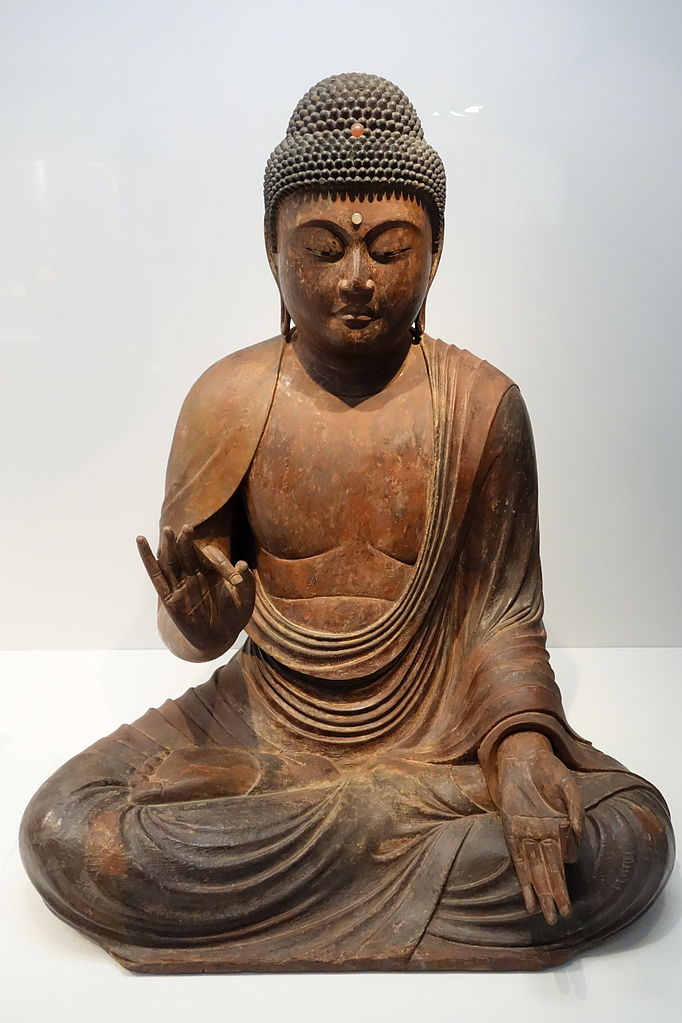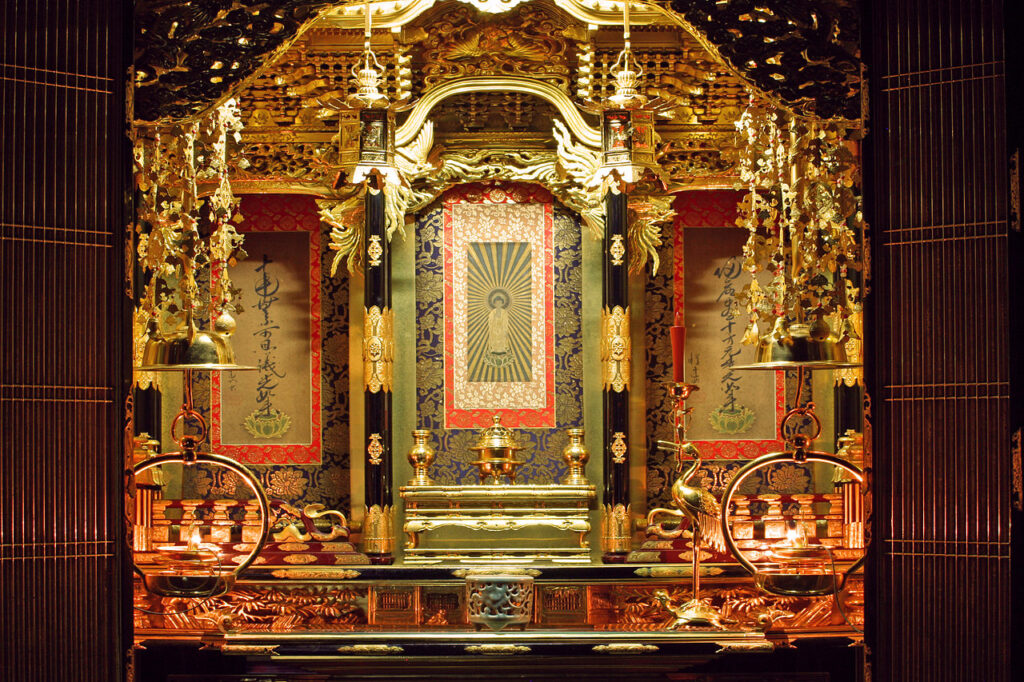In traditional Mahayana Buddhism, the issue of the nature of Amida was addressed in terms of the trikaya doctrine which distinguished three embodiments of the Buddha, the nirmanakaya (the historical Sakyamuni Buddha), the sambhogakaya (the reward body of a bodhisattva who has become a buddha, referred to as a celestial buddha), and the dharmakaya (ultimate reality). As the reward body of the bodhisattva Hozo (Skt Dharmakara), who had vowed to establish a Pure Land for those spiritually unable to reach enlightenment on their own, Amida clearly fitted the description of a celestial buddha.
Thomas Kasulis, however, remarks that “it does seem peculiar that Shinran would advocate absolute faith in a non-absolute form of the Buddha and so, as we might expect, his theory is more complicated. In fact, for Shinran, Amida is the “cosmic embodiment” as the dharmakaya, ultimate reality, buddha-nature – and also the cosmic embodiment as heuristic expression (skillful means). The question is: how can you be the “cosmic” embodiment of a skillful means, if that is what a celestial buddha is said to be?
At this point I’d like to turn to Dennis Hirota’s entry on Japanese Pure Land Buddhism in the Stanford Encyclopedia of Philosophy, where I found a more straightforward explanation. Hirota is critical of the way modern scholarship understands the nature of a celestial buddha.
Hirota’s starting point in his section on the nature of Amida is a comparison between Sakyamuni Buddha and Amida Buddha. He writes: “While Amida, Buddha of infinite light and eternal life, may be regarded as the “celestial” personification of perfect wisdom-compassion, and the narrative of his attainment in the inconceivable past as “mythic,” Gotama, known by his honorific title Sakyamuni Buddha, is recognized as a historical figure … in the fifth century BCE. It is common to say, therefore, that Sakyamuni belongs to the realm of historical fact and actual existence, while Amida is fictive … Sakyamuni, having become the “awakened one” through meditative practices, taught his realization to others, and among the teachings attributed to him is the story of Amida Buddha. The story of Amida is considered such a “skillful means” (hōben) or mythic device for teaching.”

This, Hirota adds, has also been the view of “sophisticated Buddhists such as those of the Tendai, Shingon, and Zen schools [who have] recognized all along that Amida is merely a skillful “metaphor” or “symbol” for the historical realization of Sakyamuni.”
According to Hirota, this interpretation does not reflect early Pure Land Buddhist views. He writes: “There is basic continuity in the perspective on Amida among the Mahayana schools” that “stands diametrically opposed to modernist assumptions. For Mahayana Buddhists, reality resides not fundamentally with the historical existence of Sakyamuni as such, but rather with that for which he is recognized as buddha, or that which is the motive-force for his appearance in the world, his attainment of buddhahood, and his teaching of dharma. Reality assumes “form” in order to emerge into the consciousness of sentient beings and thereby guide beings“ beyond both attachments and discriminative thinking. In other words, buddha-nature, as it were, “creates” or “manifests” as the form of a celestial buddha as well as that of a historical buddha to generate a circular moving between “formless reality” and “the world of form.” Hirota, here, quotes a text by Honen:
“Sakyamuni discarded the supreme Pure Land and appeared in this defiled world; this was to expound the teaching of the Pure land and, by encouraging sentient beings, to bring them to birth in the Pure Land. Amida Tathagata discarded this defiled world and emerged in the Pure Land; this was to guide sentient beings of this defiled world and bring them to birth in the Pure Land. This is none other than the fundamental intent with which all buddhas go out to the Pure Land and emerge in the defiled world.”
In Honen’s view, then, “Sakyamuni and Amida function as paired aspects of a movement of compassionate activity in teaching and guiding, out of true reality into the defiled world, and out from the defiled world into “the supreme Pure Land” that is the abode of all buddhas.” Here, Hirota says, Honen begins with Sakyamuni, “even though Amida’s attainment of buddhahood occurred aeons prior to Sakyamuni’s appearance. Without Sakyamuni, Amida would remain unknown to beings in this world [but] without Amida, Sakyamuni would have no effective means of liberating beings … In place of a linear chronology, we have a motif of movement between the timeless and mundane time, by which the temporality of karmic causation and discriminative thinking is broken.”
Hirota then explains that, while taking on board the notion of a “movement between the timeless and mundane time,” Shinran “gave priority to Amida.” Thus, “for Shinran, it is the motive-force of wisdom-compassion that underlies the historical existence of Sakyamuni—that in fact made him buddha—and this wisdom-compassion is itself the life of Amida Buddha. Hence, Sakyamuni’s historical existence may be understood as a manifestation of Amida, perhaps one among countless others.”
Shinran justifies his move by invoking the Sutra of the Tathagata of Immeasurable Life, where it is said that “prior to expounding dharma, the Buddha enters a profound samadhi and delves to the nondiscriminative wisdom that transcends words and concepts. On emerging from the samadhi, he reemerges into the realm of words and responds to questions from his disciples. While his words are those of ordinary human discourse, they give expression to the samadhi he attained … On this basis he reveals the story of Amida, for Amida is the primordial Buddha who embodies the essence of all Buddhas.” This means that “were it not for Amida, whose Buddhahood lies at the heart of the samadhi of great tranquility, Sakyamuni himself would not be Buddha.”
Thus, the relationship between Amida and Sakyamuni is not that between two distinct figures, or between the religious symbol taught and the teacher. As Kasulis suspected, Amida stands both “in formless reality and the world of forms, in the eternal and in history.” Amida is an embodiment of the dharmakaya (formless reality), and the embodiment of a “celestial buddha,” that is not just a human device to teach, but, we could say, Amida-as-ultimate reality expounding the truth. Just as Dainishi is said to be in Shingon. Kasulis comes to a very similar conclusion.
Hirota concludes the section on the nature of Amida by noting that “while meditative traditions in Buddhism tend to emphasize … the apprehension of formless reality free of the imposition of egocentric discrimination, the Pure Land tradition is attentive to the compassionate working of reality to awaken beings incapable of eradicating conceptual thought … Late in life, Shinran adopted the term jinen, “naturalness” or “being made to become so of itself,” for the spontaneous working of reality in the liberative process by which beings of afflicting passions reach enlightenment.” As illustrated by the well-known story of the drowning sailor, who becomes exhausted after swimming for hours in search of a land, finally gives us, ready to die, turns on his back, and realises that the ocean is “supporting” him without him having to do anything, reality is teaching us and supporting us, and we can entrust our faith to it. “ In this process, the Mahayana assertion that “samsara is none other than nirvana” or “afflicting passions are none other than awakening” is affirmed, so that the end of the Pure Land path lies in this world, in the compassionate working for the liberation of all beings.”
Sources:
Thomas P. Kasulis: Engaging Japanese Philosophy
Dennis Hirota: Japanese Pure Land Philosophy entry in the Stanford Encyclopedia of Philosophy

